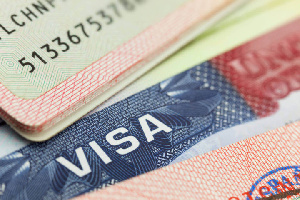In the last few months or even years, many Ghanaians have emigrated in search of greener pastures in foreign countries.
This was not worrying until the Ghana Health Service started beating the drums on how their members abandoned their posts for the same adventure; greener pastures.
If you have been travelling around or wish to travel, you might have heard about the Schengen countries. In this GhanaWeb article, we put the spotlight on how to get a Schengen Visa, the countries that fall in this category, and all the information you need about it.
What is Schengen Visa?
Schengen is the EU passport-free zone that covers 27 European countries. It is the largest free travel zone in the world for tourism and business purposes. Having a Schengen Visa allows you to travel to any country in the Schengen Area and allows you to stay for 90 days in a 180-day period.
That means that for every 90 days you spend in the Schengen area, you must spend 90 days outside of it. If you wish to study, work, or live in one of the countries for longer than 90 days, you’ll need to apply for a national visa from that European country instead of the Schengen visa.
An article by citizenremote.com, states that there is no border control in these countries, so you can move back and forth as you please.
However, the report added that recent security concerns have created the need for better management of who is entering EU borders. That is why the European Travel Information and Authorization System (ETIAS) was created.
The ETIAS is a completely electronic system that allows keeping track of visitors from countries who do not need a visa to enter the Schengen Zone. The system will start in January 2024, and they hope to be fully operational in November 2023.
What are the Schengen countries?
There are 27 countries which can issue a Schengen Visa, find below the complete list:
Austria
Belgium
Czech Republic
Croatia
Denmark
Estonia
Finland
France
Germany
Greece
Hungary
Iceland
Italy
Latvia
Lithuania
Luxembourg
Malta
Netherlands
Norway
Poland
Portugal
Slovakia
Slovenia
Spain
Sweden
Switzerland
Liechtenstein
Types of Schengen Visa
You’ll need a Schengen visa if you’re visiting for one of the following reasons:
Business purposes
Visiting friends or family
Tourism
Holidays
Cultural or sports events
Transit
Medical reasons
Short-term study
Research purposes
Depending on why you’re visiting the Schengen countries, you may be granted a single-entry visa, a double-entry visa, or a multiple-entry visa.
Below is how citizenremote.com explains the types of visas:
Single-Entry Visa
A single-entry visa allows the holder to enter the Schengen Area only once within the given period of time. Once the holder leaves the Schengen Area, they can’t re-enter it using that visa, even if they have not spent the number of days permitted.
Don’t get confused; a single-entry visa does not mean you can only enter one country. You can enter through any country from the Schengen Area and keep moving around the 27 countries.
Double-Entry Visa
The double-entry visa works similarly to the single-entry visa. The difference between them is that, unlike the single-entry visa, the double-entry visa allows you to re-enter the Schengen Area one more time after you have left it.
With this visa, you won’t be allowed to enter a third time when you leave the Schengen Area a second time. So be very mindful of the time you spend in the zone and ensure you don’t exceed the number of days you are permitted to stay.
And again, do not confuse the double-entry visa with the number of countries you’re allowed to visit.
Multiple-Entry Visa
Any holder of a multiple-entry visa can come and go from the Schengen Area as they please, as long as they don’t violate the 90/180 days limit.
This visa is granted depending on how frequently you travel. If you have obtained a double-entry visa more than once and you are a frequent visitor to the Schengen zone, you will most likely be granted a multiple-entry visa.
Depending on how frequently you travel, you may be granted one of these multiple-entry visa types:
1-year multiple-entry visa
3-year multiple-entry visa
5-year multiple-entry visa
1-year Multiple-entry Visa
The 1-year MEV can be obtained if you have obtained and lawfully used three visas within the previous two years. You must show proof of your previous visas when applying for this one.
The 1-year MEV allows you to enter the Schengen zone as often as you want, as long as you do not remain more than 90 days within this period.
3-year Multiple-entry Visa
You can obtain a 3-year MEV if you have used a previous multiple-entry visa valid for one year within the previous two years.
This visa gives you the right to enter the Schengen Area as often as you wish within three years. However, you must not stay for longer than 90 days within a 180-day span.
5-year Multiple-entry Visa
This visa is granted if you have previously obtained and lawfully used a multiple-entry visa valid for at least two years within the previous three years.
Same as the others, the 5-year MEV allows you to enter the Schengen Area as often as you wish within five years, but make sure you do not violate the 90/180 days rule.
Uniform Schengen Visas (USV)
The Uniform Schengen Visa is a permit given by one of the Schengen Area Member Countries that allows you to transit or reside in the desired territory for a certain period of time, up to a maximum of 90 days.
There are two categories of USV, type A and type C.
USV Category “A”
This category stands for “Airport Transit Visa”. This visa allows you to travel through the international zone of the Schengen country Airport without entering the Schengen Area.
Keep in mind that airport transit visas are mandatory for citizens traveling from one non-Schengen state to another non-Schengen state, where they change flights in a Schengen country airport.
USV Category “C”
This category stands for Short-term visa. This visa allows you to reside in the Schengen Area for a certain period of time. Short-term visas can be obtained as single-entry visas, double-entry visas, or multiple-visa entry, which we discussed above.
Limited territorial validity visas (LTV)
An LTV allows you to travel only in the Schengen State that has issued the visa. This means the holder of an LTV cannot enter or transit through any other Schengen country that is not the first and final destination target.
This type of visa is granted only on specific cases, like humanitarian reasons or under international obligation, as an exception to the common USV system.
Schengen Visa Requirements
To qualify for a visa, you must:
Be a national of a non-EU country that requires a visa
Have a valid passport
Fill up the application form properly
Show proof of financial means
Show proof of accommodations
Round trip reservation or flight itinerary
Schengen Visa Fees
Citizenremote.com explains that the standard Schengen visa fee is €80 ($80).
Children between the ages of six and twelve pay a reduced fee of €40 ($40).
Children under the age of six are entirely exempt from payment.
 Home Of Ghana News Ghana News, Entertainment And More
Home Of Ghana News Ghana News, Entertainment And More





